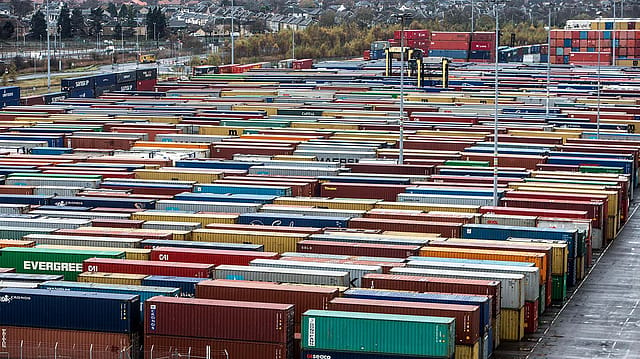India’s economy clawing back lost ground
ADVERTISEMENT

It’s official: India’s economy has recovered from the twin shocks of demonetisation and the rollout of the goods and services tax (GST). Quarterly GDP growth figures released on Thursday showed GDP grew 7.7% in January-March, its quickest pace in nearly two years that helped it retain the tag of the fastest growing economy in the world.
"GDP growth has been increasing continuously every quarter. This shows the economy is on the right track and is set for even higher growth in the future," finance minister Piyush Goyal said on Twitter after the numbers were released.
“The constant increasing trend of quarterly GDP numbers in the four quarters of 2017-18 at 5.6%, 6.3%, 7% and 7.7% indicates that the structural measures of reforms undertaken by government is now bringing rich dividends in the form of higher GDP growth rate,” said finance secretary Hasmukh Adhia on Twitter, adding that GST has given a big boost to the industrial sector.
The optimism of the government was justified. India’s fourth quarter economic growth was much faster than China’s 6.8% growth in the quarter ended in March.
Moreover, growth in agriculture was robust at 4.5%, the manufacturing sector also clocked an impressive 9.1% growth, and construction achieved double-digit growth of 11.5%. Gross fixed capital formation, an indicator of investment demand in the country, also grew at 14.4%, the highest in several quarters.
January 2026
Netflix, which has been in India for a decade, has successfully struck a balance between high-class premium content and pricing that attracts a range of customers. Find out how the U.S. streaming giant evolved in India, plus an exclusive interview with CEO Ted Sarandos. Also read about the Best Investments for 2026, and how rising growth and easing inflation will come in handy for finance minister Nirmala Sitharaman as she prepares Budget 2026.
The revival in the economy it seems could not have come at a better time for Prime Minister Narendra Modi with the poll bugle for the 2019 Lok Sabha elections already being sounded by political parties across the country.
However, look beyond the headline numbers and there is an undercurrent of clear and present danger.
The growth for the fourth quarter came on a very favourable low base as growth has stuttered to 6.1% in the fourth quarter of 2016-17 soon after demonetisation.
Private consumption is still a concern as growth declined to 6.6% from 7.3% in the third quarter. The number for the fourth quarter was the lowest in three years.
“The 9.0% growth of capital goods and the expansion in the GoI's capital spending in January-February 2018 are likely to have contributed to the healthy expansion of gross fixed capital formation (GFCF) in the just-concluded quarter,” said Aditi Nayar, principal economist, ICRA.
“Moreover, the value of new projects and completed projects contracted on a YoY [year-on-year] basis in Q4 FY2018. With fresh capacity being added by the private corporates in limited sectors, we maintain our view that the revival in investment activity is not broad-based,”
Soumya Kanti Ghosh, group chief economic adviser, State Bank of India, echoed the same sentiment.
“The construction sector has performed well after a long period of contractions and anaemic growth. The PMAY-G [Pradhan Mantri Awas Yojana-Gramin] has achieved some capital formation in the rural areas. The completed houses and houses under construction under PMAY-G till March 05, 2018 is around 23.52 lakh and 21.28 lakh respectively. The skilled and the unskilled employment generated through this scheme has somehow supported the rural consumption,” Ghosh wrote in a note.
“However noticeable revival in agriculture and contractual nature of employment in construction will prevent a lasting recovery. Policy action on exports of agriculture items needs to be implemented.”
With rising crude oil prices and uncertainty about whether the disinvestment target can be achieved, the government may not have enough fiscal leeway to keep spending and propping up economic growth.
Subhash Chandra Garg, economic affairs secretary, told reporters on Thursday he did not see a correlation between crude oil prices and economic growth. He added that the government has not lowered its economic growth forecast of 7.5% for 2018-19 and said that fiscal deficit will be within the government’s target of 3.5% of GDP.
Economists are not completely convinced with Brent crude oil prices hitting $80 per barrel for the first time since November 2014 recently.
"The high growth rate reported in quarter is on expected lines for us as the high frequency data on PMI and IIP as well as rural demand were all indicating a revival. We should, however, be wary of the headwinds the economy faces in the coming quarters from higher crude prices feeding into inflation and rising inflation expectations. We hope the Monetary Policy Committee would not press the panic button that could create further friction on growth rate and would continue to hold on to the interest rates,” said Ranen Banerjee, partner and leader, public finance and economics, PwC India.
State Bank of India’s Ghosh added, “Over the next year or so, the risks to growth are many–high oil prices and asynchronous global growth, disruption in copper supply that may have CAD impact, weather events and geopolitical risks. Policy priority needs to be reworked by streamlining the implementation of GST and fastening refunds. The fiscal pressure may rise due fall in PSU dividends, MSP support programme and has to be balanced from other sources.”
What the numbers released by the Central Statistics Office also show is that fiscal 2017-18 is the year of the slowest economic growth under Prime Minister Narendra Modi. At 6.7% for the fiscal 2017-18, India’s economy has now fallen every year since fiscal 2015-16.
Thus, while the headline numbers offer much optimism, the details show that the journey on the long road to economic recovery has only just begun.
